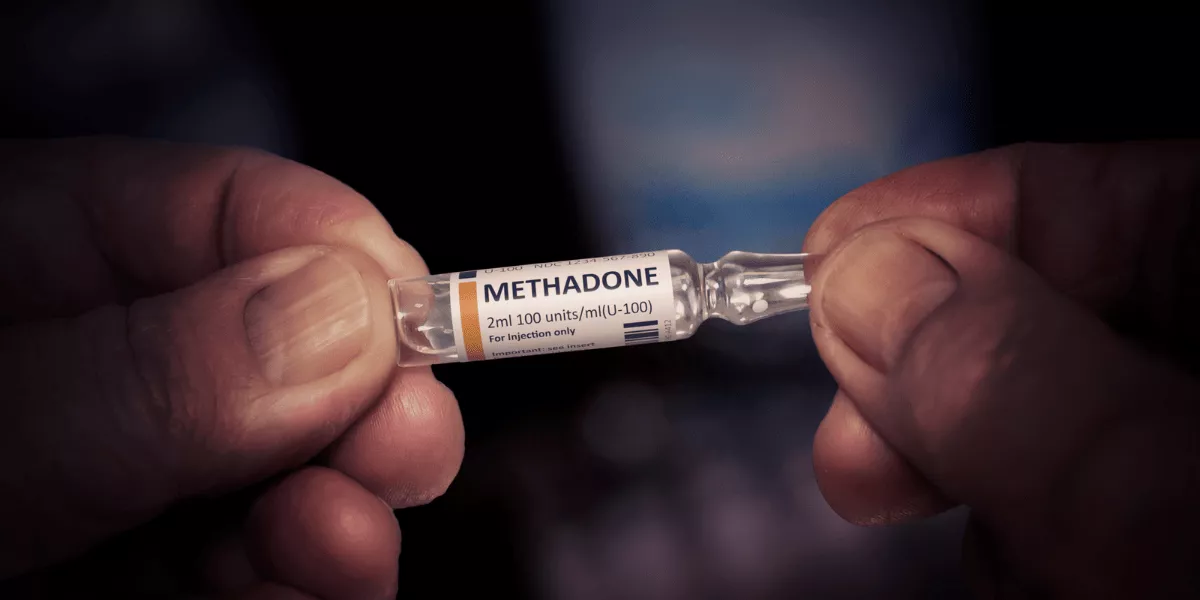Facing issues related to opioid addiction or managing the pain caused due to it can be very challenging. Methadone is a very effective medication that aids individuals in managing the said issues.
In this blog post, we will shed light on what methadone actually is, how it functions, and its advantages and risks. Let us get started:
What is Methadone and What is It Used For?: An In-Depth Look at What Methadone Is
Methadone is a form of medication that is used to treat opioid use disorder or OUD in addition to managing pain. It is deemed a long-acting complete opioid agonist. The Drug Enforcement Administration lists the medicine as a Schedule II controlled substance, primarily because of its major potential for misuse as well as addiction.
It is similar to buprenorphine in the sense that it is an effective medication to treat Opioid Use Disorder. The medication can only be dispensed via SAMHSA-certified OTPs (Opioid Treatment Programs). These programs follow very strict guidelines and regulations to ensure safety. Methadone comes in numerous forms like liquid, powder, or even diskettes. Using methadone to treat OUD is widely recommended. However, the use of methadone comes with its own set of limitations and side effects, which will be discussed later in the article.
Understanding the Mechanism of Methadone in Opioid Addiction Therapy
Blocking the Effects of Opioids
Methadone blocks or minimizes the effects that other opioids such as oxycodone or hydrocodone have. It attaches to the very same receptors present in the brain that the said drugs use, thereby blocking their euphoric or high-providing effects. This aids in preventing misuse besides keeping cravings under complete control.
The medication’s action is very slow as compared to that of strong painkillers such as morphine. This simply means that it offers a stable level within the body without leading to rapid highs or lows. Due to this, individuals are very less likely to revert to using other types of opiates.
Managing Withdrawal Symptoms
Methadone also aids in the management of withdrawal symptoms. These symptoms may include pain in the muscles, nausea, as well as anxiety. Methadone eases these symptoms by acting on the same opioid receptors in the brain as other opiates without leading to a high.
Patients consuming methadone generally find relief from opioids’ intense cravings. This makes it more convenient to completely stop using dangerous drugs and focus solely on recovery. By minimizing or preventing withdrawal symptoms, methadone leads to improved mental health as well as improved physical wellness during treatment.
Minimizing Opioid Cravings
Methadone is an opioid antagonist that aids in minimizing opioid cravings. It binds to the very same brain receptors that opioids bind to but without providing the high. This makes it very easy for individuals to remain in the best treatment plans.
High doses of methadone are comparatively more effective for heroin users. They aid in enhancing the rates of retention in drug addiction treatments. Methadone, when paired with counseling and behavioral therapy, form a very strong plan against intense cravings and relapse.
Methadone’s Therapeutic Uses
Opioid Dependence Management
Becoming dependent on opioids can prove to be life-threatening. Methadone aids in the management of opioid dependence by minimizing cravings as well as withdrawal symptoms. It functions well for individuals who are addicted to heroin, narcotic painkillers, etc. The medication also blocks the euphoric effects that these drugs offer, thereby making them much less appealing.
Patients in methadone programs generally remain on treatment for a minimum period of 1 year. This long-term usage aids in a stable recovery. Many individuals find that regular methadone doses also reduce the need to misuse other types of opioids.
“Methadone gave me my life back,” says John, who used to be a former heroin addict.
Pain Relief Applications
Methadone alters how the brain as well as the nervous system respond to pain. In simple words, it is used for pain relief. It offers relief from serious injuries, major surgeries, and even long-term illnesses. Medical professionals or doctors may prescribe the medication for the management of intense pain. This drug is highly effective because it usually lasts much longer than any other types of pain medications.
Only a medical professional can prescribe it for managing pain. Without a prescription, no individual should use it. Not abiding by the prescription or not using it exactly as prescribed may lead to major health issues, like severe heart conditions or unintentional overdose. Methadone aids tons of individuals to lead normal lives with less pain. However, it demands careful use. Hence, talking to your doctor before using it is a must.
Receiving Methadone Treatment
Required Certifications for Treatment Programs
Only OTPs that are SAMHSA-certified can dispense the medication for the treatment of OUD or opioid use disorder. This makes sure that patients get safe and regulated treatment options. Healthcare professionals who are a part of such programs are required to be qualified to oversee this form of medication-assisted treatment.
Patients who are a victim of opioid overdose must receive methadone under the supervision of a practitioner. This aids in the management of withdrawal symptoms in addition to reducing cravings. Licensed pharmacists play a major role in the entire process, ensuring the proper dosage is being taken in addition to overseeing compliance with federal guidelines.
Criteria for Methadone Treatment Eligibility
- Health Evaluation: A medical professional will review the history of your health. They inspect for other forms of conditions which may affect your treatment.
- Dependence on Opioids: You are required to present a history of addiction to opioids. This includes consuming opiate drugs such as heroin or prescription opioids.
- Age Requirement: Patients are mandated to be at least 18 years old. Certain programs might accept patients who are younger, but only if their parents agree to it.
- Counseling Commitment: You are required to agree to attending regular counseling sessions. These aid in addressing behavioral health problems in addition to supporting recovery.
- Compliance with the Rules of the Program: Abide by the rules established by the treatment center. This makes sure that every individual remains safe and keeps progressing towards recovery.
- Regular Drug Testing: Consensually submit to random tests, since they aid in verifying that you are not consuming any other type of substances.
- No Intense Mental Illnesses: Patients must not have untreated mental health issues. Proper treatment for bettering mental health is an absolute necessity first.
Methadone Safety Profile & Potential Side Effects
General Side Effects
Restlessness, nausea, as well as vomiting are some of the most common methadone side effects. Breathing problems, like a slow breathing rate, itchy and irritable skin, and intense sweating are some other side effects that methadone can cause. Some individuals may also experience constipation or sexual issues. Moreover, some users may also experience weight gain or have trouble sleeping.
Changes in appetite are another common side effect. Side effects of methadone also include severe headaches and stomach pain. Dry mouth is another common complaint amongst methadone users. Facial flushing as well as mood swings might affect certain users. Issues in vision may also arise due to drug use.
Major Health Concerns
Methadone may lead to intense side effects. Difficulty while breathing is one of the most dangerous ones. You may feel lightheaded or even faint. Certain users also get hives, rashes, and even swelling in their face, lips, tongue, or throat. Pain in the chest and enhanced heartbeats are also major concerns.
Hallucination as well as confusion may also exhibit themselves. The medication can interact with other forms of medication leading to serious heart problems. Pregnant females consuming methadone require close monitoring in order to avoid risks such as premature birth or neonatal abstinence syndrome in newborn babies.
To put it simply, individuals should stop taking methadone if they are facing serious side effects and immediately call your doctor or consult a medical professional.
Vital Considerations for Methadone Use
Recommendations for Pregnant/Breastfeeding Females
Pregnant or breastfeeding females can safely and securely take methadone. The medication aids in the management of OUD and minimizes health-related risks for both the mother as well as the baby. It does not lead to birth defects, but as mentioned earlier, babies may experience NAS (Neonatal Abstinence Syndrome).
Methadone maintenance treatment must include prenatal care. Healthcare professionals make sure that both the children as well as the mother remain safe during the pregnancy. Frequent checks are important for monitoring the development of babies and make adjustments to dosages if required.
Guidelines for Methadone Storing & Disposing
- Store at Room Temperature: Ensuring storing methadone at room temperature. Keep it away from light.
- Keep Methadone Out of Reach: Ensure that the medication remains out of children’s as well as pets’ reach. Take the help of childproof containers if needed.
- Safe Disposal: The FDA as well as DEA guidelines for disposing of methadone that is unused.
- Take-back Programs: Take part in take-back programs that are hosted by your area’s local pharmacies or agencies of law enforcement.
- Flush If Needed: Flush unused methadone down your toilet as per the recommendations of the FDA.
- Abstain from Sharing Medication: Methadone must never be shared with others, even if the symptoms are similar, since doing so can be extremely dangerous.
- Check Expiry Dates: Frequently checking the expiry dates and disposing of expired methadone is advised.
Final Thoughts
Understanding methadone aids in the treatment of opioid addiction in addition to managing pain. Methadone is used to minimize cravings and act as a barrier against the effects of other types of narcotics. Moreover, it also eases off the experienced withdrawal symptoms. All in all, it offers a plethora of side effects. However, it comes with its own set of risks and side effects.
Hence, it is advised to get in touch with and visit a reputed addiction treatment center to consult an experienced medical professional regarding the same. Using methadone under a healthcare provider’s supervision is a must.



